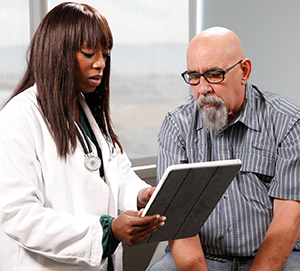Having Pericardial Window Surgery
A pericardial window is a surgery done on the sac around the heart. A small part of the sac is removed. This lets excess fluid drain from the sac.
What to tell your healthcare provider

Before your surgery, tell your healthcare provider:
-
What medicines you take. This includes over-the-counter medicines such as ibuprofen. It also includes vitamins, herbs, and other supplements. You may need to stop taking some medicines before the procedure, such as blood thinners and aspirin.
-
If you smoke. You may need to stop before your surgery. Smoking can delay healing. Talk with your healthcare provider if you need help to stop smoking.
-
If you’ve had recent changes in your health. This includes an infection or fever.
-
If you are sensitive or allergic to anything. This includes medicines, latex, tape, and anesthetic medicines.
-
If you are pregnant. Also tell your healthcare provider if you think you could be pregnant.
Getting ready for your surgery
Make sure to do the following:
-
Ask a family member or friend to take you home from the hospital.
-
Make plans for some help at home while you recover.
-
Follow any directions you are given for taking medicines and for not eating or drinking before surgery.
-
Read the consent form and ask questions if something is not clear.
-
Follow all other instructions from your healthcare provider.
Tests before your surgery
Before your surgery, you may need tests such as:
-
Chest X-ray
-
Electrocardiogram (ECG), to check the heart rhythm
-
Blood tests, to check your general health
-
Echocardiogram (ultrasound of the heart), to look at the heart and blood flow through the heart
-
CT scan or MRI scan, if your healthcare provider needs more information about the heart
-
Heart catheterization, to look at the coronary blood vessels
On the day of your surgery
Your procedure will be done by a surgeon who specializes in heart operations. They will work with a specialized team. The surgery can be done in several ways. Ask your doctor about the details of your surgery. The whole procedure may take several hours. In general, you can expect the following:
-
You may have general anesthesia, medicines that allow you to sleep through the surgery. You won’t feel any pain during the surgery. Or you may be given medicine (sedation) to make you relaxed and sleepy during the procedure. Numbing medicine may be used in the area of the surgery.
-
A healthcare provider will watch your vital signs, like your heart rate and blood pressure, during the surgery. You may have a breathing tube put down your throat during the surgery to help you breathe.
-
Hair in the area of the surgery may be removed.
-
The surgeon will make a cut (incision) a few inches below the breastbone, or between the ribs. Tools are used through this incision. If thoracoscopy is used, several smaller incisions may be made on the side of the chest instead. Small cameras and tools are inserted through these small incisions.
-
A small piece of the pericardium is removed. This creates a small window in the sac.
-
A tube may be put between the layers of the pericardium or in the cavity of the lungs. This is to help drain the fluid. A sample of the fluid may be sent to a lab for analysis.
-
The incisions will be closed with stitches or staples. A bandage will be put on the area.
After your surgery
After the procedure, you will spend several hours in a recovery room. You may be sleepy and confused when you wake up. Your healthcare team will watch your vital signs, such as your heart rate and breathing. You will likely have a tube draining the fluid from your heart or chest. You may feel some soreness, but you shouldn’t feel severe pain. You’ll be given pain medicine if you need it. You may be in the hospital for a few days. You will be able to drink the day after surgery. You can have regular food as soon as you are able.
Recovering at home
Follow all the instructions your healthcare provider gives you for medicines, exercise, diet, and wound care. You may feel tired for days or a week or more after the surgery. You should be able to go back to your normal activities soon. Ask your healthcare provider if you can exercise. Don’t lift anything heavy for several weeks.
Follow-up care
You will have your stitches or staples removed in a follow-up appointment in 7 to 10 days. Make sure to keep all follow-up appointments.
When should I call my healthcare provider?
Call your healthcare provider if you have any of the below:
-
Fever of 100.4°F (38.0°C) or higher, or as advised by your healthcare provider
-
More fluid draining from the wound
-
Swelling of the legs or abdomen
-
Persistent nausea or vomiting
Call 911
Call 911 if any of the following occur:
-
Chest pain that gets worse; or unusual chest pain
-
New, or worsening, difficulty breathing
-
Fainting or lightheadedness
-
Any other severe symptoms
Online Medical Reviewer:
Mary Mancini MD
Online Medical Reviewer:
Ronald Karlin MD
Online Medical Reviewer:
Stacey Wojcik MBA BSN RN
Date Last Reviewed:
4/1/2022
© 2000-2024 The StayWell Company, LLC. All rights reserved. This information is not intended as a substitute for professional medical care. Always follow your healthcare professional's instructions.